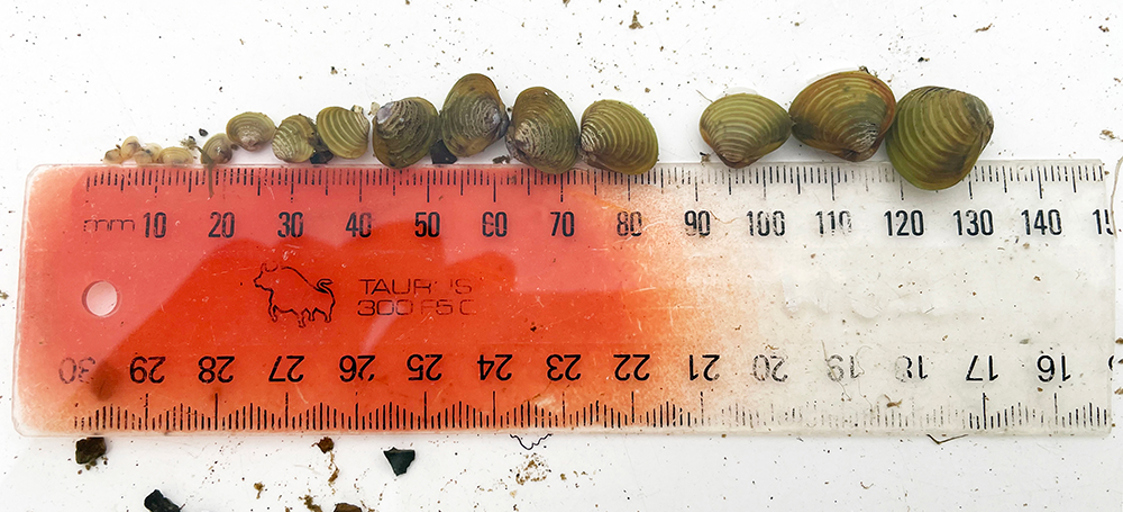Invasive freshwater clam (Corbicula fluminea)
A serious threat to Northland’s freshwater ecosystems
The invasive freshwater clam Corbicula fluminea, (previously known as the gold clam), is an invasive freshwater mollusc that poses a serious threat to New Zealand’s rivers, lakes, infrastructure, and native biodiversity.
First detected in the Waikato River in 2023, this species reproduces rapidly, able to produce up to 400 juveniles in a day. Invasive freshwater clams can spread easily through the movement of watercraft, trailers and equipment. It is now considered one of the most concerning aquatic pests in the country.
Early detection, containment, and strict biosecurity practices are essential to prevent its spread.
The invasive freshwater clam reproduces rapidly and in large numbers, able to produce 400 juveniles a day and up to 70,000 juveniles a year, allowing them to reach high densities in optimal conditions.
They are highly adaptable, and once introduced to a waterway, they are extremely difficult to manage. No country has successfully eradicated them. Exclusion of invasive freshwater clam from Northland and long-term containment to the Waikato river is the focus of management for this species.
Key concerns include:
- Ecological impact: Competes with native species like kākahi (freshwater mussels) for food and habitat, potentially displacing them.
- Water quality degradation: Can worsen nitrogen and phosphorus levels, disturb sediments, and reduce dissolved oxygen levels.
- Cultural and recreational loss: Threatens mahinga kai and the health of rivers used for swimming, boating, and fishing.
- Infrastructure damage: Dense populations can clog hydroelectric plants, irrigation systems, and water treatment facilities.
- No known eradication method: Overseas attempts have failed; long-term suppression and containment are the only viable options.
- Adult clams are 2–3 cm long, typically dirty white, yellow or tan, with a distinct ribbed shell texture.
- Found in lakes, and rivers down to where saltwater and freshwater mix
- Sitting on top of, or buried in sandy, gravel or muddy substrates.
See MPI’s factsheet for identification tips and photos.
Currently confirmed in:
- Waikato River – from Lake Maraetai to Port Waikato.
- Lake Rotomanu, New Plymouth – detected in November 2025.
- Taupō Aqua Park – Corbicula australis detected in 2024.
Most of Aotearoa’s rivers and lakes are considered vulnerable. Surveillance is ongoing, but early detection is difficult due to its small size and ability to hide in sediment.
Corbicula fluminea and Corbicula australis have been given the legal status of an Unwanted Organism under the Biosecurity Act 1993. This means that people must not knowingly move them or water that may contain them. To do so would be an offence under the Biosecurity Act.
In Northland
- We have a freshwater biosecurity checkpoint that operates over summer at Kai Iwi Lakes, educating lake users about freshwater biosecurity threats and ensuring watercraft arrive clean and dry. From December onwards, we will be implementing a self-certification portal that requires all users of Kai Iwi Lakes to certify that they have followed Check, Clean, Dry protocols before arriving at the lakes. Go to our self-certification information.
- Our Check, Clean, Dry ambassadors will be out and about this summer, promoting freshwater biosecurity. If you see them, please come and have a chat for more information.
- We have an active Enviroschools programme, designed around promoting the Check, Clean, Dry message in schools. For more information about this programme or if you would like us to visit your school, please get in touch.
A coordinated national response is underway, involving:
- Biosecurity New Zealand, regional councils, iwi, and industry partners.
- Controlled Area Notices (CANs) in place for the Waikato River and Rotorua Te Arawa lakes.
- Long-term management plan developed to guide suppression, research, and public awareness.
- Suppression trials and habitat studies are informing future control strategies.
Follow Check, Clean, Dry protocols:
Check
- Remove any plant matter, mud or visible weed or clams from your gear and leave it at the river or lake bank, or put it in the rubbish. Drain all river or lake water from your boat, ballast tanks and gear.
Clean
- Blast your gear and craft with tap water onto grass, not into a stormwater system or drain.
- For absorbent materials, use one of the following treatments.
- Soak in hot tap water (50°C to 55°C) for at least 5 minutes, or
- Soak in 5% bleach solution (5 litre mix = 250ml bleach in 4.75 litres water) for an hour, or
- Freeze till solid (overnight), or
- Soak in salt solution at 100ppt (parts per thousand) (5 litre mix = 500g salt in 5 litres warm water) for 4 hours.
Get a full list of approved treatments, including options for situations where none of the above is suitable, from mpi.govt.nz - Treatment options
Dry
Dry areas inside watercraft where water has pooled, then leave the craft to dry for at least 48 hours (2 days).
Allow gear to dry to touch, inside and out, then leave it to dry for at least 48 hours (2 days) before using again.
More information can be found on the MPI website at: mpi.govt.nz
- Do not move or disturb the clams
- Take a photo and note the location.
- Report it immediately to Biosecurity New Zealand:
- Call 0800 80 99 66
- Or use the online reporting form




